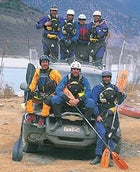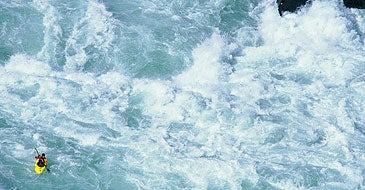ON FEBRUARY 16, 2002, Scott Lindgren powered his kayak into a maelstrom of enormous boulders and deafening whitewater, boofed a ten-foot vertical drop, and sliced smoothly left through a needle’s eye of rock at the bottom before the thundering water could pile-drive him into an undercut block. Farther downriver, he hit the edge of a six-foot-deep, river-wide hole and rode a jet of current around to the right before sprinting to safety in a boiling eddy. One after another, his companions—a handpicked squad of six of the world’s most able big-water kayakers—hit other shore eddies, threw their paddles clattering among the boulders, and stood to look at each other with a wild surmise. Fourteen days and dozens of Class V+ rapids after setting off from the remote Tibetan village of Pe, they had completed the first descent of the Upper Tsangpo Gorge—known among paddlers as the “Everest of Rivers”—one of the most daunting and dangerous adventures ever undertaken.
Tsangpo River team
 Clockwise from top left: Willie Kern, Lindgren, Knapp, Johnnie Kern, Fisher, Ellard, and Abbott before putting at Pe
Clockwise from top left: Willie Kern, Lindgren, Knapp, Johnnie Kern, Fisher, Ellard, and Abbott before putting at PeTsangpo River

Flowing 700 miles east across the Tibetan Plateau, the Tsangpo (called the Yarlung in Chinese) drains the north slope of the Himalayas before plunging into the gorge. Here it flows between two massive, 23,000-foot-plus peaks, Namcha Barwa and Gyala Pelri, before hanging a sharp right and diving south through a corridor of almost vertical rock, eventually emerging onto the jungled plains of India as the Brahmaputra. From the plateau, the river loses 9,000 feet of altitude in 150 miles. In parts of the upper gorge, the drop is even more drastic—the equivalent of tilting the Colorado River in the Grand Canyon and jacking up its steepness more than 20 times.
Generations of paddlers have written off the Tsangpo as an impossibility, but Lindgren, a 30-year-old Emmy-award-winning adventure filmmaker from Auburn, California—who has spent the last ten years pulling off pioneering descents of Himalayan rivers—has had the gorge in his sights for nearly a decade. In May of 1998, Lindgren visited the Tsangpo and considered an attempt before deciding the flow was suicidally high. (A paddler would die attempting the Gorge later that year, the second Tsangpo fatality in a decade.) The next spring, when he again scouted the river, it was still too dangerous. But the reconnaissance gave him an idea: If an expedition were willing to trade the high monsoon runoff for the brutal Himalayan winter, when the Tsangpo flows at its lowest (still more powerful than most rivers in the world), running the gorge might be possible.
Over the next three years, Lindgren quietly began laying the foundation for his epic attempt, recruiting an experienced ground crew and some of the best expeditionary kayakers in the world. Paddlers Steve Fisher, 26, from South Africa, Mike Abbott, 29, of New Zealand, Allan Ellard, 27, from England, Dustin Knapp, 24, of Jacksonville, Oregon, and twin brothers Johnnie and Willie Kern, 30, from Stowe, Vermont, all signed on for the trip, with ���ϳԹ��� and Chevy Avalanche as major sponsors. The logistics of the ���ϳԹ��� Tsangpo Expedition seemed insurmountably complex, but when the kayakers first gathered in Lindgren’s home, shortly before their departure in January, Scott’s confidence and enthusiasm were infectious.
“Most of us had paddled so much together we already trusted one another,” says Knapp. “We were confident that we would do what we could do.”
On January 21, the team flew out of San Francisco bound for Lhasa, Tibet, where they packed three trucks to the brim for a two-day journey to the launch point, near the southeastern edge of the Himalayas. By the time the expedition mustered at the riverside village of Pe on February 1, the group was 87 members strong—seven paddlers, seven media and support staff, five climbing Sherpas from Nepal, and 68 Tibetan porters toting 2,500 pounds of food and gear, including laminated copies of high-resolution satellite images that enabled the paddlers to “virtually scout” almost every mile of river.
The expedition began in earnest two days later, when the seven paddlers, clad in drysuits, slipped their boats into the 40-degree Tsangpo and entered the 44-mile-long upper gorge. Meanwhile, the ground crew shouldered their loads and began the arduous trek along the river’s right bank.
The Tsangpo was at its deep-winter low ebb. Still, the kayakers immediately felt the power of the biggest, most continuously fearsome water they had ever paddled—15,000 cubic feet per second, dropping 100 to 200 feet per mile in some sections. “The danger was constant,” recalls Mike Abbott. At the first big rapid where the river constricted into a steep white flume, Steve Fisher elected to paddle the left side solo and was flipped three times in a steep ledge fall and a violent cliffside eddy. Attacking a thundering two-mile alley of cliffed-out whitewater they dubbed the Northeast Strait-away, the kayakers crossed from bank to bank, portaging when necessary and seal-launching into the current from huge boulders. “A swim at any point” says Abbott, “would probably have been fatal.”
On day ten, negotiating another constricted section, Johnnie Kern hit a massive lateral wave guarding a must-make eddy just as it surged. He was tossed upside down, landing in the maw of a churning Class V rapid. Fisher followed, but his paddle came unglued on impact. Using half the paddle, he dropped into another giant hole. Both paddlers managed to muscle and finesse their way out of peril and escaped unscathed. Four days later, when the seven kayakers eddied out just above the unrunnable torrents of Rainbow Falls, they had made history.
Incredibly, the most harrowing days still lay ahead, during an epic, 96-hour portage above the falls and over a 12,000-foot pass called Sechen La, a brutal trek never before attempted in winter. The group threaded its way up treacherous couloirs and 50-degree snow slopes, cutting steps with ice axes. After several close calls, the exhausted and battered group eventually rejoined the river near its confluence with a large tributary, the Po Tsangpo.
The lower gorge served up a major surprise. Twenty-one months earlier—after the team’s precise satellite images had been taken—a cataclysmic flash flood had scoured the banks to a 300-foot swath of near-vertical bedrock. Realizing it was impossible to scout the inaccessible stretches and unknown features downriver, Lindgren made the difficult but prudent decision to end the expedition. “No one will ever march in here and run the lower gorge,” he predicts.
The titanic whitewater and the otherworldly journey over the Sechen La may have been the expedition’s biggest obstacles, but they were not the only challenges: Porter mutinies and impossibly dense bamboo thickets helped make the ���ϳԹ��� Tsangpo Expedition the most intense journey any of the participants had ever undertaken.
“The stars were lined up,” Lindgren says. “Nobody said we could pull this off. But we did.”


